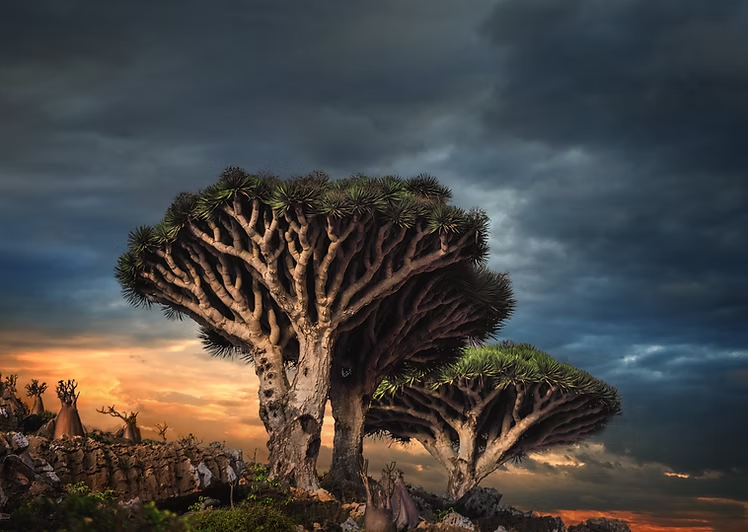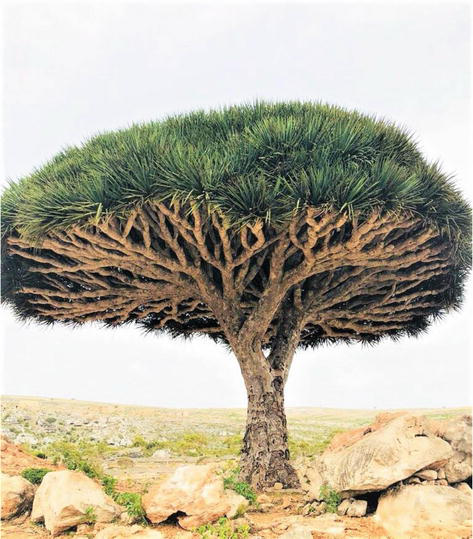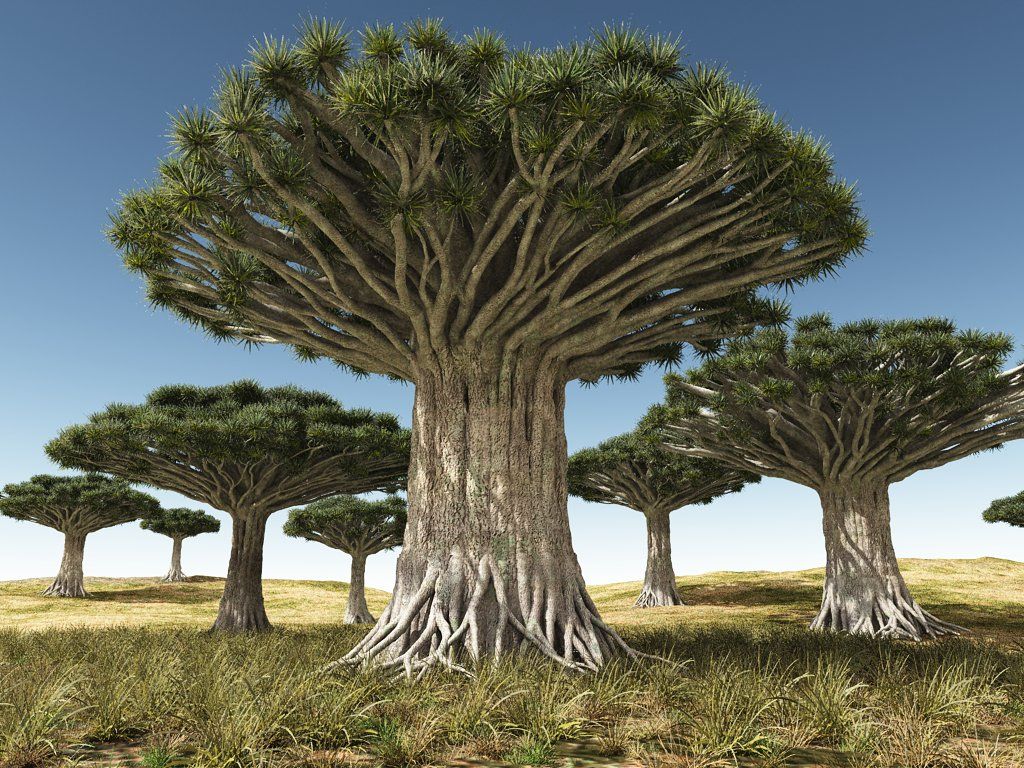The Dragon Blood Tree (Dracaena cinnabari) — Nature’s Mythical Marvel of Socotra Island
Among the many wonders of the plant kingdom, the Dragon Blood Tree (Dracaena cinnabari) stands out as a truly remarkable and mysterious species. With its striking, umbrella-shaped canopy and its vivid red sap — often called “dragon’s blood” — this ancient tree has inspired myths, medicinal traditions, and scientific curiosity for centuries.
Native exclusively to the remote Socotra Archipelago, an island group off the coast of Yemen in the Arabian Sea, the Dragon Blood Tree is a living symbol of resilience and adaptation. It thrives in one of the harshest environments on Earth and plays a vital ecological role within its fragile ecosystem.
1. The Unique Appearance: Nature’s Umbrella
At first glance, the Dragon Blood Tree captivates with its surreal, almost otherworldly silhouette. Its branches grow densely upwards and then curve outward to form a broad, umbrella-like crown. This unusual shape is not just for show — it’s a brilliant evolutionary adaptation.
The dense canopy provides shade that helps reduce evaporation from the rocky, arid ground beneath, creating a microhabitat that supports other plant and animal life. The umbrella shape also collects moisture from the air, especially from fog and dew, which then drips to the base, nourishing the tree in an environment where rainfall is scarce.
The branches are thick and covered with tough, leathery leaves that cluster at the tips in dense rosettes. The leaves are narrow and sword-shaped, a characteristic common to species in the Dracaena genus.
Some trees can grow up to 12 meters (about 40 feet) tall, but what’s truly mesmerizing is the overall structure — it looks like a giant green mushroom or an ancient alien tree, making it instantly recognizable and iconic.

2. The Blood of Dragons: Red Resin
The name “Dragon Blood Tree” derives from the tree’s deep red resin, known as “dragon’s blood.” When the bark or leaves are cut or damaged, this bright red sap oozes out, resembling fresh blood — a spectacle that likely inspired local myths about dragons and magical creatures.
This resin isn’t just visually striking; it has been highly valued throughout human history for its practical and mystical uses:
- Ancient Dye and Pigment: The resin was ground into powder and used as a vibrant red pigment for dyeing textiles, coloring art, and illuminating manuscripts. It was prized in various cultures, from the ancient Greeks and Romans to medieval European alchemists.
- Medicinal Properties: Traditional societies have used dragon’s blood for its purported healing properties. It has been applied to wounds as an antiseptic to stop bleeding and promote healing. Some cultures also used it to treat respiratory issues, digestive problems, and skin conditions.
- Ritual and Spiritual Uses: Dragon’s blood has held a place in religious and magical ceremonies. It was burned as incense in rituals to ward off evil spirits, cleanse spaces, and invoke protection. Its intense red color symbolized life, power, and vitality.
Scientific studies have since confirmed that the resin contains compounds with antimicrobial and antioxidant properties, lending some credence to its traditional medicinal applications.
3. Socotra Island: The Dragon Blood Tree’s Only Home
The Dragon Blood Tree is endemic to Socotra Island, a UNESCO World Heritage Site known for its extraordinary biodiversity and high number of endemic species — plants and animals found nowhere else on Earth.
Socotra lies in a strategic location near the Horn of Africa and the Arabian Peninsula, isolated by the surrounding desert and ocean currents. This isolation allowed unique species like the Dragon Blood Tree to evolve independently.
The island’s climate is hot and dry, with little rainfall and frequent droughts. Soils are often rocky and nutrient-poor. Despite these harsh conditions, the Dragon Blood Tree thrives by tapping into underground water reserves and maximizing moisture capture from humid winds.
Socotra’s landscape is dotted with stands of Dragon Blood Trees, which form unique forest ecosystems. These groves provide essential shelter and food sources for endemic birds, insects, and reptiles, sustaining a complex web of life adapted to the island’s challenging environment.

4. Evolutionary Marvel and Adaptations
The Dragon Blood Tree belongs to the Dracaena genus, a group of plants related to lilies and asparagus. While many Dracaena species grow as shrubs or small trees in tropical forests, the Dragon Blood Tree’s umbrella shape is an adaptation unique to the arid conditions of Socotra.
- Water Conservation: The umbrella canopy reduces direct sunlight on the trunk and soil, helping conserve precious water. The thick waxy leaves reduce water loss through transpiration.
- Fog Harvesting: The tree’s shape and leaf arrangement facilitate the capture of fog and dew. These tiny water droplets then run down the branches to the roots, supplementing scarce rainfall.
- Slow Growth and Longevity: The Dragon Blood Tree grows slowly and can live for hundreds of years, a testament to its resilience in a tough environment.
5. Ecological Role and Importance
The Dragon Blood Tree is a keystone species on Socotra Island. Its presence shapes the local ecosystem by:
- Creating shade that allows other plants to grow.
- Providing habitat and nesting sites for endemic birds and insects.
- Offering a food source through nectar from its flowers and fruits for various animals.
- Stabilizing soil and preventing erosion in mountainous and rocky terrain.
Without these trees, the island’s biodiversity would be drastically different, illustrating how one species can influence an entire ecosystem.
6. Threats and Conservation
Despite its resilience, the Dragon Blood Tree faces significant threats due to human activity and environmental changes:
- Habitat Degradation: Overgrazing by goats, unsustainable harvesting, and land development reduce the number of mature trees.
- Climate Change: Altered rainfall patterns and increasing temperatures strain the already limited water supply.
- Limited Range: Being endemic to a single island makes the species vulnerable to extinction from disease or catastrophic events.
Conservation efforts are underway to protect the Dragon Blood Tree and its habitat, including:
- Establishing protected areas.
- Educating local communities on sustainable land use.
- Supporting reforestation and propagation programs.
Preserving this iconic tree is essential not only for biodiversity but also for the cultural heritage of Socotra’s inhabitants.

7. Cultural Significance and Uses
For centuries, the Dragon Blood Tree’s resin has woven itself into the folklore and traditions of Socotra and beyond. The mystical allure of “dragon’s blood” has inspired stories about dragons, magic, and healing.
Locals traditionally harvest the resin carefully, balancing use with sustainability. The resin continues to be sold as a natural dye, medicine, and incense.
In modern times, the tree’s unique form has attracted ecotourism, scientific research, and artistic inspiration, highlighting the importance of integrating conservation with cultural appreciation.
8. Fascinating Botanical Facts
- The Dragon Blood Tree produces small, fragrant white or greenish flowers clustered on the branch tips, usually blooming in spring and summer.
- The fruit is a berry containing seeds that can be dispersed by birds.
- The resin hardens upon exposure to air, turning from a sticky liquid to a solid gum.
- Despite its tough exterior, the tree is sensitive to overharvesting of resin, which can weaken or kill it.
- It has been described by explorers and botanists as one of the most “alien” looking trees on Earth.
9. Scientific and Medicinal Research
Modern science has begun unlocking the secrets of the Dragon Blood Tree’s resin. Studies have identified:
- Antimicrobial compounds effective against bacteria and fungi.
- Antioxidants that help neutralize harmful free radicals.
- Anti-inflammatory agents that support traditional uses for wound healing.
These discoveries raise the possibility of new pharmaceutical applications, though sustainable harvesting remains a concern.
Conclusion: The Dragon Blood Tree — A Living Legend
The Dragon Blood Tree is not just a tree; it is a living legend embodying the mysteries and resilience of life on a remote island. Its spectacular appearance, unusual biology, and valuable red resin have earned it a place in human history and the natural world’s wonder.
Protecting this botanical marvel means preserving an irreplaceable part of Earth’s heritage — a tree that truly bleeds magic, supports an entire ecosystem, and continues to inspire awe in all who encounter it.

